Food is art
(the USA)
The United States is a rich and varied blend of
peoples, religions and cultures, and this diversity is reflected in its
cuisine. Succeeding waves of immigrants, including those arriving on the United
States' shores today, have brought new culinary traditions and adapted them to
the ingredients, kitchens, and customs they found in their new homeland — ever
expanding what is called "American food".
Despite the rise in popularity of many other ethnic
cuisines, it is Chinese and Italian restaurants that dominate this field.
A bit later came the big one: Italian-American food.
The real triumph of the cuisine is in the US’s home - where pizza, lasagna,
manicotti, meatballs, veal parmigiana play a tremendously vital role in the
everyday fare of American citizens.
When Americans were asked to choose typically national
food of their country, hamburgers and cheeseburgers (29%), apple pie (20%) and
hot dogs (13%) topped the list. The only other two foods mentioned by
significant numbers were barbecue (9%) and fried chicken (7%). 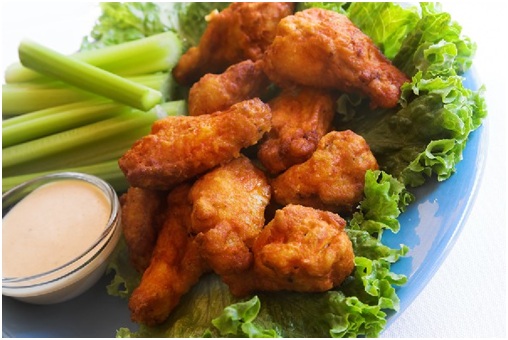
A whole new year of food holidays means more than 365
days of different food festivities. Each month has foods with entire dedicating
feasting months, plus foods with special feasting weeks. For instance, there
are
Bread Machine Baking Month
National Candy Month
National Egg Month
National Hot Tea Month
National Meat Month
National Oatmeal Month
National Soup Month
National Wheat Bread Month
Prune Breakfast Month
Sounds like a culinary poem, doesn’t
it?
Other exciting events are National Pizza Week (the second week of the
month), National Meat Week (the fourth week), and National Irish Coffee Week
(also the fourth week). And if you didn’t have enough pale gold Champagne on
December 31, start the New Year with something bright and colorful:
January 1 is
Bloody Mary Day and also Apple
Gifting Day,
January 2 is National Cream Puff Day,
January 3 is Chocolate-Filled Cherry Day,
January 4 is National Spaghetti Day,
January 5 is National Whipped Cream Day,
January 6 is Bean Day,
January 6 is National Shortbread Day,
January 7 is National Tempura Day,
January 8 is English Toffee Day,January 9 is National Apricot Day,
January 9 is National Apricot Day,
January 10 is Bittersweet Chocolate Day,
January
11 is Milk Day. 
Thanksgiving Day
The event that some Americans commonly call the
"First Thanksgiving" was celebrated by the Pilgrims to give thanks to
God for guiding them safely to the New World. The first Thanksgiving feast
lasted three days, providing enough food for 53 Pilgrims and 90 Native
Americans. The feast consisted of fish (cod, eels, and bass) and shellfish
(clams, lobster, and mussels), wild fowl (ducks, geese, swans, and turkey),
venison, berries and fruit, vegetables (peas, pumpkin, beetroot and possibly,
wild or cultivated onion), harvest grains (barley and wheat), and the Three
Sisters: beans, dried Indian maize or corn, and squash. The New England
colonists were accustomed to regularly celebrating
"thanksgivings"—days of prayer thanking God for blessings such as
military victory or the end of a drought. 
To sum up, Americans take the food for a solid joy.
Every day is a culinary festivity for them. Moreover, the most important day of the USA history cannot be
imagine without a good meal with a rich turkey. It is wonderful to enjoy
workaday things!
Many a little make a mickle (Australia)
Australian cuisine
Australian cuisine consists of Indigenous Australians’
cuisine and cuisines of first immigrants who came from east (Asian cuisine) and
west (Britain cuisine). There you can meet meal from deferent countries, like
American fast food or Britain porridge. Indigenous Australians’
cuisine is based on using a lot of different natural spices which are made from
plants growing on Australian territory. 
Australian tries to eat natural products which are low
in fat and salts. They usually eat vegetables, fruits, seafood, kangaroo meat.
Bushfood
Bushfood – bush tucker in Australia. It traditionally
relates to any food native to Australia and is used for culinary purposes by
Australian Aborigines. Examples of Australian native animal foods (meats)
include kangaroo, ostrich emu and crocodile. Kangaroo is more common and it can
be found in supermarkets cheaper than beef. Other animals, for instance goanna
and grubs were eaten by aborigines of Australia.
Also there are plenty examples of Australian native
fruits such as quandong, kutjera, muntries, riberry, finger lime.  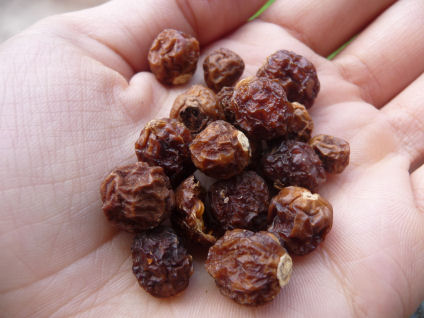 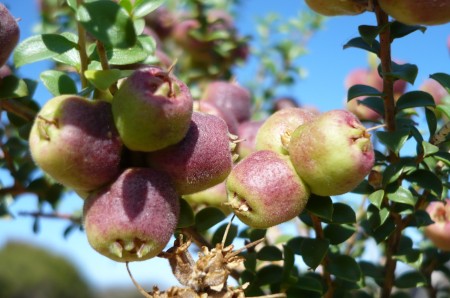
quandong kutjera muntries
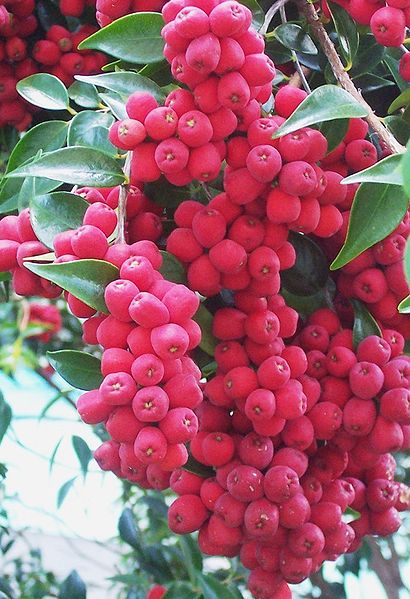  riberry finger lime
Aboriginal use
Many foods are also baked in the hot campfire
coals, or baked in ground ovens for several hours. There are a lot of toxic
seeds but after removing the toxins it becomes safe to eat. Bush bread was made
by women using many types of seeds, nuts and corns to process a flour or dough
to make bread. From immigration in 1788 the introduction of non-native foods to
aborigines of Australia has resulted in an almost complete abandonment of
native foods by aborigines.
Colonial use
Of course immigrants preferred eating familiar
food, but they ate bush foods too as extra meal, not as primary one. Immigrants
just were not fond of strong flavor meal. However, strong flavors are now
highly regarded for culinary use. Immigrants grow their native vegetables,
fruits, animals to eat.
Nowadays use
In the 1970s non-indigenous Australians began
to recognize native Australian foods and in the end of 1970s farmers started to
assess native food-plants for commercial use and cultivation. In 1980 meat of
kangaroo was legalized as human food. Different analysis and tests showed that
some kinds of native Australian food were exceptionally nutritious. In the
middle of 1980s Australian restaurants began using native spices to add the
special flavor for their meal.
Drinks
Billy tea is the drink prepared by boiling
water for tea over a camp fire and adding a gum leaf for flavoring and remains
an iconic traditional Australian method for preparing tea, whic was a staple
drink of the Australian colonial period. 
The Australian Wine
Industry is the 4th largest exporter of wine in the world with 760 million
litres a year to a large international export market. Australians consuming
nearly 500 million liters of wine per year in the beginning of 21st Century. 
Breakfast The
breakfast frequently resembles breakfast in many Western countries. In warmer
areas, breakfast is generally light. In
colder seasons, porridge or a full English breakfast may be consumed. The light
breakfast commonly consists of breakfast cereal, toast, and fruit. 
Dinner
The evening meal is the main meal of the day
for most Australians. Common choices would be roast meat and vegetables, pasta,
pizza, casseroles, barbecued meat, fish and seafood, vegetables, salad, soup,
curries and stir-fries.
Iconic Australian
foods
The Australian hamburger is, at its simplest, a fried
beef patty, served with shredded lettuce and sliced tomato in a bread roll,
usually toasted. Tomato sauce (similar to ketchup but made with real tomatoes
and less sugar with a more liquid texture) or barbecue sauce are almost always
included. Beetroot, pineapple and fried onions are also extremely common
additions. 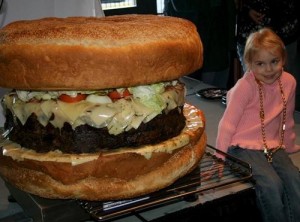 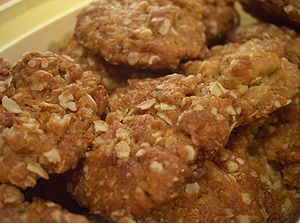
ANZAC
biscuits and the pavlova are considered
by some to be Australian national foods, although while the oldest known named
recipe for pavlova is from New Zealand, its often said in the Australian
history that the dessert took its name from Anna Pavlova at the Esplanade Hotel
in Perth during a tour of the state where she danced "as light as
air" in reference to the light meringue. 
Kangaroo
meat is widely available in Australia although it is not among the most
commonly eaten meats. In old fashioned colonial recipes, it was treated much
like ox tail and braised until tender forming rich gravy. It is available today
in various cuts and sausages. Also eaten (in specialist
restaurants) is emu meat, crocodile meat and occasionally (although rarely)
wombat.Damper is traditional Australian soda bread prepared
by swagmen, drovers and other travelers. It is wheat flour based bread,
traditionally baked in the coals of a campfire.  As we see, Australian cuisine is quite rich and even
multi-cultural. Also Australian food looks appetizing, doesn’t it?
By Valentin Alexeev
the student of class
10A,
Xenia Protasova
the student of class 7A
| 
